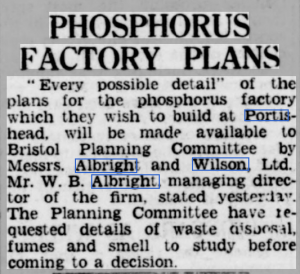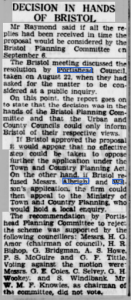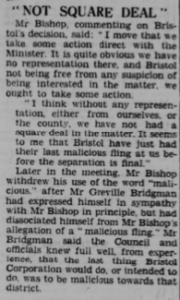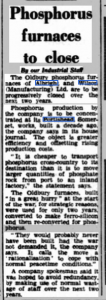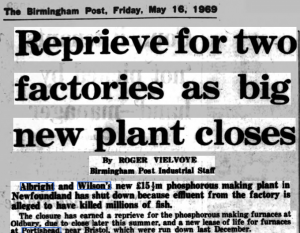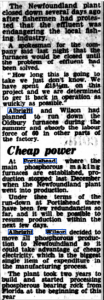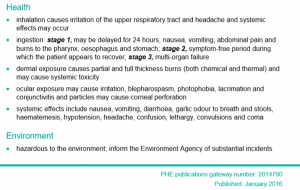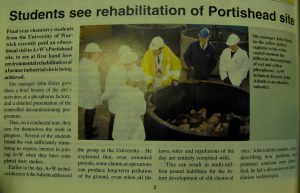The Portishead site near Bristol was built to provide increased white phosphorus capacity post war. The location was chosen primarily because of its dockside availability for the receipt of phosphate ore by sea and also adjacent power station and rail links.
It was modelled on the Oldbury plant, and it is worth mentioning here that British Agent/AW engineer Alf Loveless would before this site was built have inspected the Nazi phosphorus factories in Germany to add to that efficiency endeavour.
The planning history of this site is typical in that it was not wanted locally, but forced upon the area by a greater authority. At this point in time, the wretched founding families were still in control of Albright and Wilson and through their positions in society could buy anything that they wanted, including planners.
AW had originally tried to look for a site in Scotland, no doubt which would have given the war dodging coward Bill Albright an opportunity to commute North for his favourite pastime of grouse shooting whilst conducting “business.” Scotland gained however from this avoided pollution nightmare, and Portishead got it instead.
An article from The Birmingham Daily Gazette of 27th June 1950 states that lack of black country manpower was one reason why the phosphorus polluters of Oldbury chose to spread their vileness elsewhere. Cost cutting was the other. At this point in time going forward, Albright and Wilson the company were actively recruiting cheap foreign labour, particularly from Italy, whose new arrivals would ask few questions- especially about health effects from working conditions.
But in an age before social media and the internet, those outside of Oldbury (except the surrounding districts affected by the waft of cat piss), would have known little about their abysmal health and safety failings and impact of phosphorus production coming out of Trinity Street. Smaller councils were obviously at a grave disadvantage of accepting this industrial giant’s assurances of not causing “nuisance”. The following article from The Western Daily Press 16th August 1950 outlines that this 20 acre site factory would require extensive alterations to the existing Portishead docks and railway sidings and local roads. There would be six steel and concrete silos at 100ft high and the phosphorus furnace itself occupying 45,000 square feet. There would be an import of 200,000 tonnes of phosphate rock which it laughably states would cause no nuisance or traffic problems.
Further on in his report to the Long Ashton rural council, Mr Foster, the planner however backtracks on this. It is stated that he was treated to a tour of the dire Oldbury factory and stated that “there would be no appreciable smoke nuisance, and that there was no risk of fumes damaging crops in the area.”
One can only wonder from this if Mr Foster and co were visiting a Trinity Street site in some form of parallel universe at this point in history, or if he had been provided with a suitably fat brown envelope just to make his false claim.
Already local people in Oldbury had suffered years worth of being a potential target at the hands of the Nazi bombers for this WW2 phosphorus producer, only to be rewarded with vile smells and pollution after 1945 in a new commercial enterprise that put their health at serious risk. There would be a problem with “smoke” and there would be nauseating problems with fires, explosions and fatalities at Oldbury. Foster would have done better actually talking to local people about their experiences of living next to a phosphorus factory with “unbearable smells” rather than the bull shitters like the “Quaker” conman W.B Albright , but planners are seldom ever interested in the realities of a situation, just the economics of their masters.
Portishead Urban council however would not be so easily pushed aside.
From 22nd August Western Daily Press, this authority was concerned about such realities. Bristol Planning committee were to make the decision on the factory. It is clear that local opposition to the AW machine was gathering pace in the form of petitions. This is something omitted from the company history books about Albright and Wilson, like many other inconvenient truths and the manner in which their apologists have attempted to claim that they were the area. .
People were concerned that the residential area would be turned into a sprawling chemical dump, but their concerns were largely ignored by one of the worst planning reports I have ever seen.
The statement concerning “no objectionable smells” being present during the Oldbury furnace tour are again laughable. Oldbury workers themselves called it “old smokey” and the pollution was bloody awful and creaking with industrial disease. Similar claims about no pollution are again the words of a bent council officer shilling the Albright and Wilson lies. The report is one of almost total fiction, no doubt supplemented by dishonest scumbags like Loveless and Albright.
Talk about “no hardship” to local residents from fume loss are grotesque in their lack of understanding of phosphorus pollution and the insidious real dangers. Similar nonsense is spilt with talk of effluent- of course phossy water – which would prove the unravelling of the future plant at Long Harbour built after this factory.
Claims about trade waste are also lies, we know full well the types of wastes containing phosphorus dumped at Rattlechain.
Talk about good health records of workers at Oldbury are also lies. They were contracting phossy jaw well into the next decade. “Medical advisors” at A/W were unprofessional company manipulators who lied about the dangers of exposure to asbestos.
Another article the next day underlined the situation that Portishead council were in and also how members of the public had had little time to object to a meeting that they could not even address.
“Portishead has always been noted as a beautiful residential resort. Here you are going to stick a stinking chemical factory in the middle of it.”
A further article appeared in the same paper two days later, and it is clear that the shyster Albright was doing everything possible to try to shit on local residential opposition. I wonder if the Nazi furnaces that his mate Loveless had gained industrial knowledge from on behalf of The British Government would also be made available for inspection to compare their similarity? The liar would have course submitted nothing about Rattlechain lagoon, which by now was well established, as well as the real problems that existed at his disgusting cancer and industrial disease belching anus of a factory due North.
It was clear from the next instalment of this debate on 2nd September 1950 that PDC councillors were not as gullible in falling for the AW crap fantasy stories. Unfortunately these bureaucratic multi councils were typical of the times, and still unfortunately are. PDC as representative of their immediate area wanted the greater authority at Bristol to reject the factory as it would “injuriously affect the amenities of Portishead district as a whole”.
The meeting had once again seen the coward Albright could not give any guarantee about future plans for this factory and if more than phosphorus would be made here. As it would transpire it would not be long before that happened!
The statement made concerning health effects and the manufacture of phosphorus are totally bogus and obviously written by another bought AW shill. The effects of P4 production were well known at this time, and certainly to Albright and Wilson. The medical adviser was an imbecile. Similar statements made about effluent are also laughable. Even more so are the statements about the glow of phosphorus and naked flames from the furnaces at Oldbury, which AW claimed could be concealed at Portishead.
Claims about dust nuisance were equally bogus.
In response to the points about the effects on the wider area the real answers were
(a) The effect of fumes on residents in the area would be a persistent nuisance- as they proved to be at Oldbury. They would also be a chronic threat to human health.
(b) The effluent ,really phossy water, was a major toxic threat to fish and beaches in the Weston Super Mare area- as later evidenced by the disastrous Albright and Wilson operation at Long Harbour. Then there was of course the regular pollution to canals at Oldbury by the carriage of said effluent by barge.
We then get a comment from a “Mr Clarke” of Albright and Wilson. This was the same wretched fool that was involved in the production of AW bombs. His claims about fumes , deposits and threat to vegetation and effluent, could therefore be summarily dismissed as pure fiction. THEY WERE ALL OCCURRING AT OLBURY UNDER HIS FAILED MANAGEMENT AT THIS VERY POINT IN TIME!
Portishead council had wanted a public inquiry into a proposed factory rather than this crooked and unscrutinised deal between Albright and Wilson and planning officers. The decision however would rest with Bristol planners.
And so it was on 7th September 1950 The Western Daily Press reported that Bristol had given the nod to the Oldbury scumbags to have their way. Most telling is that this meeting was closed to the press and was only communicated to PDC after the meeting. One wonders if this was some Grand Lodge love in . Whatever it was , it was not above corrupt.
Portishead immediately called for a public inquiry. They were not given any representation at the closed private Bristol meeting. A smell was admitted by Albright and Wilson- that being a great understatement!
Not surprisingly, the call was turned down as The same paper reported later on 7th November. The claims that Albright and Wilson made about mitigating the effects of fumes and problems would quickly be unravelled to be pure fantasy.
On 9th November another Weston Daily Press article records the official view received from The Minister at the time Hugh Dalton, an extremely weak economist in the Labour Government. His comments about phosphates being “in the national interest” are almost straight out of the mouth of Albright and Wilson themselves, and echo those of the fellow Labour rimmer in chief at Oldbury Samuel Melsom.
The factory was built and production of phosphorus started in February of 1954. The method of production by the electrothermal process is set out HERE.
A cutting from The Birmingham Daily Post of 13th March 1954 shows the vista that now existed at the Portishead docks- another industrial polluting blot on the landscape. The article explains how the created phosphorus – a claimed capacity of 40,000,000 pounds would be transported by rail to their other recently built site at Kirkby near Liverpool.

The vertical rubber pipe on the right was part of the suction apparatus for unloading cargoes of phosphate rock, they were transferred to the long covered conveyor belt which extended to the six storage silos. The molten P4 was transferred in the rail wagons in the centre of the picture.
An important reference to this money making scheme and all of the claims that Albright and Wilson and its management had made and all that the planning officers had failed to investigate was revealed in a written Hansard question by a Mr Edwin Leather MP for North Somerset on 17th May 1954.
It calls for action to be taken against Albright and Wilson for “certain nuisances” being caused by the factory which were of “a longstanding nature of complaints”. It also refers to failed promises being made by the company – just as was the case at Oldbury. It also refers to “the fumes” and if these were dangerous to human health. OF COURSE ALL OF THESE ISSUES HAD BEEN RAISED BEFORE THE FACTORY WAS BUILT, AND HAD BEEN IGNORED BY THE FOOLS AT BRISTOL PLANNING AUTHORITY.
Unfortunately the mealy mouthed response from The Attorney General Lionel Heald was also typically similar of those excuses made by the Albright and Wilson political shill at Oldbury Samuel Melsom. (Ironically Heald had prosecuted the white phosphorus poisoner Louisa Merrifield the previous year). It appears that PDC had taken evidence of the real nuisance that the factory was causing, just as they had envisaged when their objections were ignored.
A decade would pass before stirrings that all was not well with the Portishead operation came to light. The Birmingham Daily Post article from 19th February 1964 stated that the Oldbury phosphorus furnaces were to close and instead the operation focussed at Portishead in a rationalisation exercise.
This would in fact not happen and production continued at both. The Albright and Wilson move to produce phosphorus instead at Newfoundland at Long Harbour, would reveal just how damaging a phosphorus factory and its effluent problems could be when millions of fish were killed with phossy water and the area contaminated. Two new ships had been commissioned to deliver white phosphorus straight to Portishead from this new site in from March 1969, yet almost straight away the management had to take evasive action.
The Birmingham Daily Post of 16th May 1969 reported that both The Oldbury factory and the Portishead furnaces which had been shut down just months earlier were to continue use. It also explains the production line process of white phosphorus from New Foundland via Portishead to Oldbury.
DECOMMISSIONING AND DISASTER- AND THE RATTLECHAIN LINK
After AW finally overcame their disastrous operations at Long Harbour, it is alleged that a programme of decommissioning began of the furnaces at Portishead. This period is by their own design extremely sketchy as to what they actually did with the materials and scrapped plant . It is clear that the satellite waste dump at Strode Road Clevedon had been used for many years as a repository which contained white phosphorus, but not in a lake as at Rattlechain lagoon. Minutes of a meeting of Clevedon Town council reveal that the Woodspring district council had been told by AW in 1979 that “under no circumstances should the ground be dug up now or any time in the future.”
Three lagoons or “phossy pits”at Portishead were also said to be in operation at the factory itself in the decommissioning report which occurred many years later. Details of these however were extremely sketchy and anecdotal.
Despite no longer making phosphorus at Portishead, it was still brought there from Long Harbour. In August 1990 one of the most spectacular health and safety failures occurred when many drums of white phosphorus went up in smoke, and certainly put Portishead on the map. This is how The Liverpool Echo reported the “major incident” drama the following day.
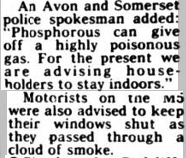 It was reported afterwards that the warehouse contained more than 30 tonnes of P4 in 166 drums, each holding 200kg. The explanation into the cause was that overnight one of the drums had caught fire spreading to the others. Over 100 firemen brought the blaze under control and it was clear that toxic white phosphorus vapour and breakdown products were given off over a 15 mile area, just as they would at Oldbury some 19 years later. It apparently also set off smoke detectors in guest houses in Weston Super Mare- perhaps a throwback to one of the dismissed claims against the new factory made many years earlier.
It was reported afterwards that the warehouse contained more than 30 tonnes of P4 in 166 drums, each holding 200kg. The explanation into the cause was that overnight one of the drums had caught fire spreading to the others. Over 100 firemen brought the blaze under control and it was clear that toxic white phosphorus vapour and breakdown products were given off over a 15 mile area, just as they would at Oldbury some 19 years later. It apparently also set off smoke detectors in guest houses in Weston Super Mare- perhaps a throwback to one of the dismissed claims against the new factory made many years earlier.
Unfortunately as they always did, Albright and Wilson were quick to try to downplay this incident, blaming the hot weather and putting some form of “Dunkirk spirit” in the fantastical bullshit written in Albright World. They claimed that 167 drums were damaged or destroyed out of 366 held. A sandbag lake was created to attempt to contain the obvious major pollution, though what effect this had is unclear. The dock lowered by 30 inches due to the volume of water being used to fight the fire- but where did all of this heavily contaminated phossy water go back to?
It appears that Oldbury manager and PR guru Peter Bloore was sent to address a press conference and a Portishead Town Council meeting.
Despite his mild mannered calm, (of course which made him more believable to a duped crowd), Bloore was an insidious chemical industry public relations liar, who communicated and altered his knowledge with a forked tongue and a pointed tail. He personally told me that the waste at Rattlechain was “the stuff used in toothpaste” calcium phosphate, omitting any mention of white phosphorus contained within it. This same phrase was repeated by another liar- the health and safety manager at Albright and Wilson and then Rhodia who would no doubt have learned this distorted perversion of truth from “Dr phosphorus” himself.
Some of the claims attributed to him in Albright World following this incident are quite marked to illustrate this very point.
Bloore “sought to allay many of the fears and misgivings expressed at the meeting that had resulted from the fire” yes just as Albright and Wilson had tried to do before they had brought their contaminating factory there in the 1950’s.
“Peter added that A+W’s record with drummed phosphorus over many years, in many parts of the world, has been extremely good.”
In reality concerns about this had been expressed and in the public domain.
- At rattlechain in the 1950’s and during the time that the thief Ernest Sulley had been operating at AW.
- There were concerns in the 1970’s about cyanide at their tips which they claimed not have dumped there.
- And did “Willy” Peter tell them of the white phosphorus fire at Rattlechain only months earlier when barrels had been emptied out and a white phosphorus fire had started there?
- Did he also tell them of the insane Mike “willy” Peters who used to shoot barrels of contaminated waste with his gun on pallets at rattlechain to sink them out of site?
- In fact in this very week of the fire in 1990 at The Gower Tip in Oldbury, Firemen had discovered drums of phosphorus pentasulphide above the surface. What phossy whoppers this man spun for Albright and Wilson and his pension!
- It should also be advised at this time, as an EA report in 1997 noted, that senior manager’s bonusses were linked to environmental performances. If you could pin the blame on weather, acts of God, or anything then they would try it on. You could also of course be rewarded for attempting to cover them up.
There is also mentioned the following quote by another AW liar in attendance “Dr” Malcolm Cathcart the then “company medical adviser.” “Only short term effects were likely to have been experienced as a result of the smoke and fumes (which are not toxic) arising from the fire.”
This statement is knowing pure blatant lies.
- Phosphorus vapour is “toxic”. It is a COMAH dangerous substance.
- Phosphorus pentoxide is “toxic”. It is a COSSH substance hazardous to health
- This leads on breakdown to phosphoric acid, another COSSH substance hazardous to health.
- Both can cause chronic illness .
- These are the statements about these breakdown products made by The Health and Safety Executive when they investigated the uncontrolled release at Oldbury from the 2009 fire.
The Public Health England Guidance on white phosphorus incident management 2016 makes it specifically clear in its key points, that the oxides arising from uncontrolled releases of white phosphorus are “toxic”.
Further points on health are also clearly specific, and if the representatives of AW communicated anything less than this to their audience they were doing so to mislead them over the threat to their human health.
We have then a situation in 1990 where many tonnes of dirty toxic waste and scrap special waste contaminated material would need to be disposed of quickly- and at cheapest cost to Albright and Wilson. Portishead within a short span of time would be decommissioned, and turned into a financial gain for this company in the form of a dockside housing conglomerate.
The “early” decommissioning itself, as revealed in the later Over Arup Report was done by Albright and Wilson themselves in a closed operation. The report frequently refers to disposal of contaminated white phosphorus waste arisings being removed to a “licenced tip”, but not the name of the said tip. There is also talk of recycling some of the material and taking it by tanker to Oldbury.
Another factor to consider is a response from the Environment agency concerning an FOI request asking them about the licence at Rattlechain and when certain records of substances within the auspices of the licence were last deposited at the site.
The answer for these amounts and waste types are very interesting and within the timescale when the Albright and Wilson “decommissioning” were taking place, and after the 1990 fire.
(iii) Can you confirm the years when returns for Inert solid waste contaminated with elemental phosphorus 1,182.35 tonnes were filed until- e.g. from start of license until which date?
“The last reported deposit of this waste type was in October 1997.”
(iv) Can you confirm the years when returns for Water contaminated with elemental phosphorus or phosphoric acid or sulphur 3,550.96 tonnes were filed until- e.g. from start of license until which date?
“The last reported deposit of this type of waste was in October 1992.”
Albright and Wilson/Rhodia have stated that “scrap machinery” went into rattlechain, though are not specific as to whether all of this came from Oldbury, or elsewhere in their factory empire.
I believe it is entirely plausible that the waste crap that Albright and Wilson didn’t want from Portishead went straight down the tip to Oldbury. There is nothing in the licence SL31 which states that the waste HAD to be from the Oldbury factory only. This is just another loophole and another way which this useless licence could be exploited, to a cost cutting solution to AW.
Within AW, they bizarrely attempted to use this contaminated site as an educational resource by showing students around the site! Asbestos amongst other things was found yo be lying around in bags here as revealed in the decommissioning report AFTER these visits. If anyone reading this recognises themselves and has or does contract any serious illnesses in later life, perhaps this is a good starting point for the claims solicitors, and what conditions Albright and Wilson were operating under during their “decommissioning” and under the auspices of The Health and Safety at Work Act 1974 with regard to site visitors.
“He explained that, over extended periods, some chemical operations can produce long term pollution of the ground, even when all the laws , rules and regulations are entirely complied with.” (or when they aren’t like Albright and Wilson.)
“This can result in multi million pound liabilities for the future development of old chemical sites”
Indeed, during their decommissioning, Albright and Wilson were fined for enriching radioactive phosphorus, again a hazard to human health and its workers. I have gone into detail about this HERE. Bloore and co showed around more students in another “Albright World” article telling them more tall stories and also about how the plant at Portishead had started to be decommissioned as soon as the furnaces there had been shut down (in 1972).

Bloore amongst others stands next to what I believe to be one of the water filled phossy pit with a group of students
I have gone into depth looking at the decommissioning report, after AW had finished their messing around at the site HERE. It has to be said that some of this process leaves some questions behind as to where Albright and Wilson’s white phosphorus contaminated material went to, and whether any of was just buried and left behind. As with other sites, including rattlechain, Albright and Wilson told the consultants what they wanted to tell them, leaving many blank spaces and questions about their commercial activities when they operated as a factory. Covered up but not totally were all of the unsafe practices, the dangers to health of workers (eg loose asbestos tipped in with “domestic waste”) as well as the threat to public and environmental safety- all the things that had been raised by Portishead council back in the dark days of 1950.
From out of a vile polluting phosphorus factory, that most of Portishead didn’t appear to want, came a new marina housing complex. Once again Bristol City Council were involved in the scheme. Perhaps Portishead is the Albright and Wilson bastard child that finally got “cleaned up”- but only perhaps to another of their bastard sites elsewhere…….
















